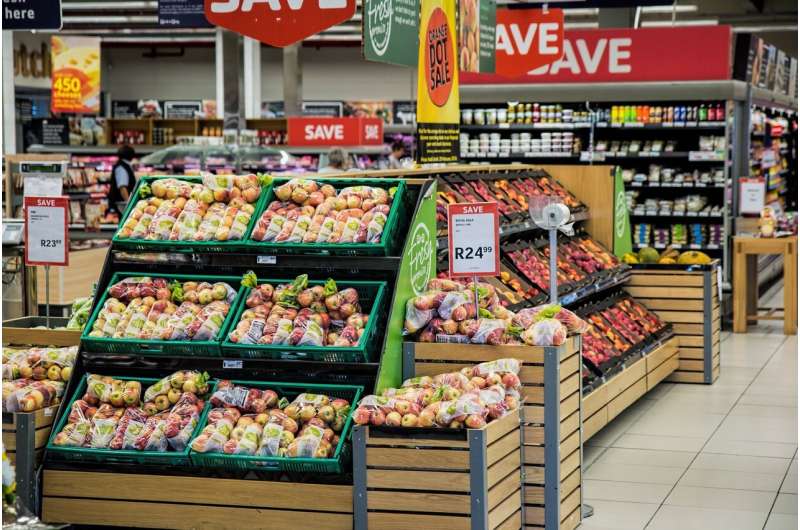This article has been reviewed according to Science X's editorial process and policies. Editors have highlighted the following attributes while ensuring the content's credibility:
fact-checked
trusted source
proofread
A new digital ecosystem to boost food safety

Trust is a highly valuable asset for food supply chains, especially when it comes to exports. Buyers look for proof that rigorous regulations around food safety and other expectations have been met.
Dr. Ryan McAllister is our Trusted Agrifood Exports Mission lead. He said Australia benefits from great systems and an enviable reputation developed over many decades, but there are some significant inefficiencies.
"The people who buy our Australian products love them. However, food producers and processors alike can feel burdened by complex and costly regulations.
"The current system to monitor food safety has many manual steps and duplication of reporting. It makes it difficult to scale to grow our export value."
We want to grow Australia's agricultural and food export value. This goal includes realizing higher premiums across a range of commodities.
Digitizing safety compliance and quality assurance data is critical to reducing the regulatory burden. It can also unlock insights and opportunities for food producers and processors.
Growing trust by streamlining reporting
Our aim is to create an interconnected food assurance system that will boost trade and build the value of Australian agricultural exports into the future.
We're partnering with the Australian government's Department of Agriculture, Fisheries and Forestry (DAFF) and engaging with state regulators to make this a reality.
"The system needs to ensure market access, while offering assurance around a range of attributes. These include food safety, biosecurity, and non-regulatory aspects such as quality, animal welfare, provenance and climate," Ryan said.
The challenge is that compliance-related data collection is often paper-based and can be piecemeal.
"So, we're developing a digital method that organizes the relevant data and specific modules that manage and assess risks at critical points."
This adds up to continuous assurance—using digital technology to collect and collate data and make it accessible to everyone who needs it from 'paddock to plate."
Turning data into real-time analysis
Our work is focused on creating a platform that takes existing compliance tasks and turns the data into something more valuable, particularly for export markets.
Dr. Bob Barlow is our Project Lead.
"Each day, processing plants, producers and others across supply chains produce an enormous amount of data to satisfy a point-in-time assessment for their compliance program," Bob said.
Most of the time, that data is only revisited when a regulatory auditor comes asking to check it. A continuous assurance system turns the same information into a real-time digital ecosystem.
"With this new digitized system data only needs to be captured or reported once. Required reporting activities move from static records to continuous, free-flowing information," Bob said.
"We're starting with food safety compliance but down the track the system will bring in aspects of quality, biosecurity, sustainability, and other credentials that are important in global trade.
"It also empowers food producers and processors to do audits on the fly and understand how they're performing across a number of metrics."
Potential multi-million-dollar savings
To pilot our approach, we've been working with major Australian beef processors Australian Country Choice (ACC) and Teys Australia. The first step was to connect the immense amount of data collected across their supply chains. This information often sits in different databases or even on disconnected systems.
"Once we start to connect these data sets, they can tell processors a lot about their business and reveal opportunities for continuous improvement, potentially in real time," Bob said.
For example, a quality assurance manager can look at the dashboard and understand how a food processing plant is performing today. They can also pull up a trend for the past week.
"ACC allowed us to look at how they generate and collect compliance data—whether manually or via sensors—producing a machine-readable data stream," Bob said.
"We went away and connected up these disparate data streams and played that back to ACC to reveal the opportunities for efficiency improvements."
It's not just food safety where it can be applied
For example, ACC's spray-chilling process helps control carcasses from shrinking during chilling. This is a challenge many beef processes need to manage, as the weight of a carcass is a major part of its market value.
In our pilot, connecting the data revealed a small percentage difference in the overnight carcass weight loss, depending on their location in the chillers.
"That information has led them to go and find out why particular pockets in chillers might be having greater moisture loss and therefore weight loss than others," Bob said.
"We've done some preliminary calculations and if we can solve that one problem, there's potentially a $5 to $7 million saving per chiller per year, at that one plant. ACC has 12 chillers and the potential to save $60 million."
It's a prime example of how continuous data analysis—on top of the essential food safety compliance—can deliver huge value to the food processing industry's bottom line.
"We believe weight-loss disparity in chillers is a common issue across the industry—let's extrapolate it and say there are 15 similar scenarios at processing plants around Australia," says Bob.
"By solving that one issue, there could be savings of $900 million a year for the industry."
Navigating compliance with real-time data
The holy grail is having data streams from multiple sources populating dashboards that update compliance in real time.
As well as making quality and other trade verifications straightforward, it could help uncover other money-saving process improvements similar to the chiller room discovery.
This innovative approach to continuous data analysis and real-time reporting is not just about meeting compliance standards. It's a strategic move towards building and maintaining trust in the global market.
Through such efforts, Australia will bolster its reputation for quality and safety in agricultural exports. Simultaneously, we can also unlock economic and operational efficiencies.
Provided by CSIRO





















